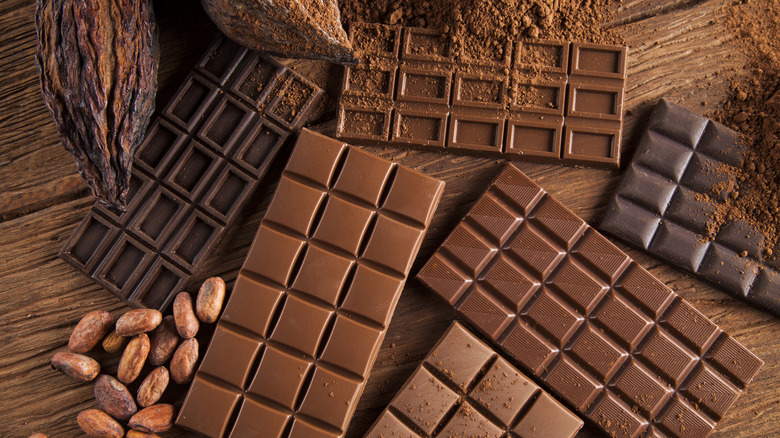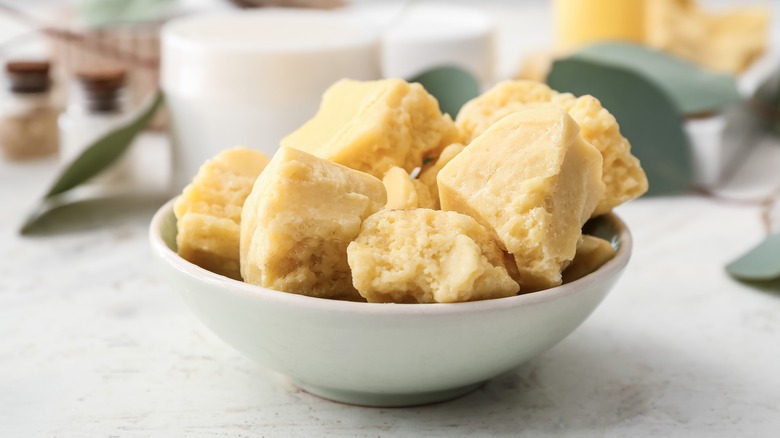What Is Couverture Chocolate, And Why Is It So Good For Cookies?
Chocolate is a beautiful thing. That smooth, rich, melt-in-your-mouth treat never fails to make our day a little better. Whether we prefer it as a decadent bar on its own, as a fine powder stirred into hot milk, or as gooey chunks that speckle our cookies (or most likely, as all of the above), chocolate simply never disappoints. Especially the really good stuff.
That's exactly what couverture chocolate is: a type of chocolate that sits a tier above the rest because of its high cocoa butter content. It's the one that chocolatiers turn to when creating those fine chocolates we all love. When you receive a box of pretty, delicate chocolates or you spot a glossy bonbon at a specialty chocolate shop, it's the couverture chocolate they're enrobed in that sets them apart.
But you don't have to be a professional to reap the benefits of couverture chocolate. You might recognize brands like Valrhona, Guittard, or Lindt, which all sell bars, blocks, or chips of couverture chocolate that you can typically find at a grocery store. It's usually worth splurging on, because that bar will take your next batch of chocolate chip cookies to their absolute highest level of deliciousness — and here's why.
Couverture is all about the cocoa butter
At its core, pure chocolate is made from three ingredients: cacao beans, sugar, and cocoa butter. Its rich, bitter, chocolatey flavor comes from the cacao beans (or more specifically, the paste or "cocoa liquor" that's made from ground, roasted cacao nibs). Chocolate's sweetness obviously comes from the sugar. And everything we love about its texture, including that quintessential melt-in-your-mouth quality, comes from the cocoa butter.
That's because cocoa butter is essentially the fat of the chocolate — it's made by extracting the fat from pressed cacao beans, which is an expensive process. Cocoa butter gives chocolate its "snap" consistency, provides that glossy finish, helps it temper wonderfully into molded bars and candies, and gives it that melty mouthfeel we all can't get enough of.
And that coveted cocoa butter is what couverture chocolate is all about. Couverture means a higher percentage of cocoa butter (a minimum of 31%, per ReadCacao, compared to 18% or 15% for a typical bar of dark chocolate or milk chocolate, respectively) is used in the chocolate-making process, resulting in a higher-quality chocolate — which is why it's many a chocolatier's choice. That extra cocoa butter results in a fine, fancy chocolate that looks shiny and tastes expensive. It's the good stuff.
Why you should use couverture chocolate in your cookies
Couverture chocolate's main draw is its superior tempering qualities, which is why it's the top choice for chocolatiers to cover, dip, coat, and mold fine chocolates. It's pretty, it's glossy, and it can add a wide array of flavor profiles depending on its tasting notes. But it's not just reserved for fancy chocolate creations you see behind glass windows in gourmet chocolate shops.
It may cost you some extra pennies, but using better-quality chocolate in your cookies will only make them that much better. This is especially true when you're making a type of cookie that's chocolate-forward or one where the chocolate can really shine — using couverture instead of your run-of-the-mill baking chocolate or bag of chocolate chips will truly set those baked sweets apart.
That's because the qualities that make couverture great for tempering will translate once that chocolate bakes inside your cookie. It will result in supremely melty, gooey chunks of chocolate that meld throughout the dough itself, leveling up the cookie's texture while enhancing its flavors with its high-quality cocoa. Next time you make a batch of cookies, look for couverture chocolate to turn good into irresistible.


